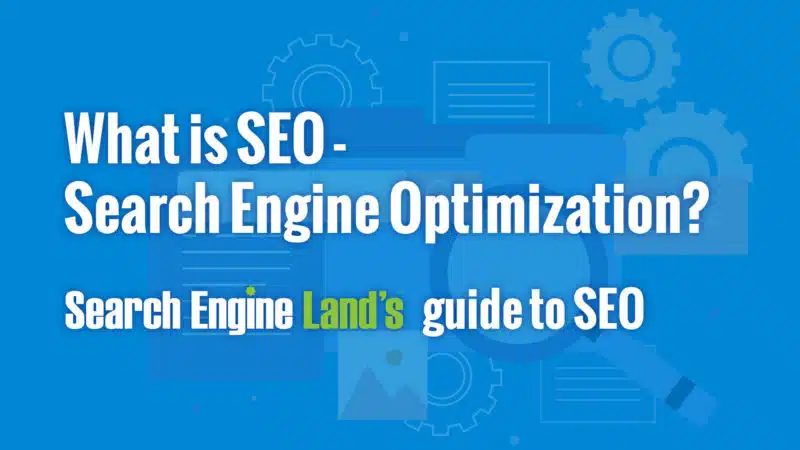What Is Search Engine Optimization (SEO)?

SEO stands for “search engine optimization (SEO).” In simple terms, SEO means the process of improving your website to increase its visibility in Google, Microsoft Bing, and other search engines whenever people search for:
- Products you sell.
- Services you provide.
- Information on topics in which you have deep expertise and/or experience.
The better visibility your pages have in search results, the more likely you are to be found and clicked on. Ultimately, the goal of search engine optimization is to help attract website visitors who will become customers, clients or an audience that keeps coming back.
Why is SEO important?
SEO is a critical marketing channel. First, and foremost: organic search delivers 53% of all website traffic.
That’s one big reason why the global SEO industry is forecast to reach a staggering $122.11 billion by 2028. SEO drives real business results for brands, businesses and organizations of all sizes.
Whenever people want to go somewhere, do something, find information, research or buy a product/service – their journey typically begins with a search.
But today, search is incredibly fragmented. Users may search on traditional web search engines (e.g., Google, Microsoft Bing), social platforms (e.g., YouTube, Facebook) or retailer websites (e.g., Amazon).
In fact, 61% of U.S. online shoppers start their product search on Amazon, compared to 49% who start on a search engine like Google. Also of note from that same research:
- 32% start on Walmart.com.
- 20% start on YouTube.
- 19% start on Facebook.
- 15% start on Instagram.
- 11% start on TikTok.
Trillions of searches are conducted every year. Search is often the primary source of traffic for websites, which makes it essential to be “search engine friendly” on any platform where people can search for your brand or business.
What this all means is that improving your visibility, and ranking higher in search results than your competition, can positively impact your bottom line,
SEO is also incredibly important because the search engine results pages (or SERPs) are super competitive – filled with search features (and PPC ads). SERP features include:
- Knowledge panels.
- Featured snippets.
- Maps.
- Images.
- Videos.
- Top stories (news).
- People Also Ask.
- Carousels.
Another reason SEO is critical for brands and businesses: unlike other marketing channels, good SEO work is sustainable. When a paid campaign ends, so does the traffic. Traffic from social media traffic is at best unreliable – and a fraction of what it once was.
SEO is the foundation of holistic marketing, where everything your company does matters. Once you understand what your users want, you can then implement that knowledge across your:
- Campaigns (paid and organic).
- Website content.
- Social media properties.
SEO is a channel that drives the traffic you need to achieve key business goals (e.g., conversions, visits, sales). It also builds trust – a website that ranks well is generally regarded as authoritative or trustworthy, which are key elements Google wants to reward with better rankings.
Types of SEO
There are three types of SEO:
- Technical SEO: Optimizing the technical aspects of a website.
- On-site SEO: Optimizing the content on a website for users and search engines.
- Off-site SEO: Creating brand assets (e.g., people, marks, values, vision, slogans, catchphrases, colors) and doing things that will ultimately enhance brand awareness and recognition (i.e., demonstrating and growing its expertise, authority and trustworthiness) and demand generation.
You maintain 100% control over content and technical optimizations. That’s not always true with off-site (you can’t control links from other sites or if platforms you rely on end up shutting down or making a major change), but those activities are still a key part of this SEO trinity of success.
Imagine SEO as a sports team. You need both a strong offense and defense to win – and you need fans (a.k.a., an audience). Think of technical optimization as your defense, content optimization as your offense, and off-site optimization as ways to attract, engage and retain a loyal fanbase.
Technical optimization
Optimizing the technical elements of a website is crucial and fundamental for SEO success.
It all starts with architecture – creating a website that can be crawled and indexed by search engines. As Gary Illyes, Google’s trends analyst, once put it in a Reddit AMA: “MAKE THAT DAMN SITE CRAWLABLE.”
You want to make it easy for search engines to discover and access all of the content on your pages (i.e., text, images, videos). What technical elements matter here: URL structure, navigation, internal linking, and more.
Experience is also a critical element of technical optimization. Search engines stress the importance of pages that load quickly and provide a good user experience. Elements such as Core Web Vitals, mobile-friendliness and usability, HTTPS, and avoiding intrusive interstitials all matter in technical SEO.
Another area of technical optimization is structured data (a.k.a., schema). Adding this code to your website can help search engines better understand your content and enhance your appearance in the search results.
Plus, web hosting services, CMS (content management system) and site security all play a role in SEO.
Content optimization
In SEO, your content needs to be optimized for two primary audiences: people and search engines. What this means is that you optimize the content your audience will see (what’s actually on the page) as well as what search engines will see (the code).
The goal, always, is to publish helpful, high-quality content. You can do this through a combination of understanding your audience’s wants and needs, data and guidance provided by Google.
When optimizing content for people, you should make sure it:
- Covers relevant topics with which you have experience or expertise.
- Includes keywords people would use to find the content.
- Is unique or original.
- Is well-written and free of grammatical and spelling errors.
- Is up to date, containing accurate information.
- Includes multimedia (e.g., images, videos).
- Is better than your SERP competitors.
- Is readable – structured to make it easy for people to understand the information you’re sharing (think: subheadings, paragraph length, use bolding/italics, ordered/unordered lists, reading level, etc.).
For search engines, some key content elements to optimize for are:
- Title tags
- Meta description
- Header tags (H1-H6)
- Image alt text
- Open graph and Twitter Cards metadata
Off-site optimization
There are several activities that may not be “SEO” in the strictest sense, but nonetheless can align with and help contribute indirectly to SEO success.
Link building (the process of acquiring links to a website) is the activity most associated with off-site SEO. There can be great benefits (e.g., rankings, traffic) from getting a diverse number of links pointing at your website from relevant, authoritative, trusted websites. Link quality beats link quantity – and a large quantity of quality links is the goal.
And how do you get those links? There are a variety of website promotion methods that synergize with SEO efforts. These include:
- Brand building and brand marketing: Techniques designed to boost recognition and reputation.
- PR: Public relations techniques designed to earn editorially-given links.
- Content marketing: Some popular forms include creating videos, ebooks, research studies, podcasts (or being a guest on other podcasts) and guest posting (or guest blogging).
- Social media marketing and optimization: Claim your brand’s handle on any and all relevant platforms, optimize it fully and share relevant content.
- Listing management: Claiming, verifying and optimizing the information on any platforms where information about your company or website may be listed and found by searchers (e.g., directories, review sites, wikis).
- Ratings and reviews: Getting them, monitoring them and responding to them.
Generally, when talking about off-site, you’re talking about activities that are not going to directly impact your ability to rank from a purely technical standpoint.
However, again, everything your brand does matters. You want your brand to be found anywhere people may search for you. As such, some people have tried to rebrand “search engine optimization” to actually mean “search experience optimization” or “search everywhere optimization.”

SEO specialties
Search engine optimization also has a few subgenres. Each of these specialty areas is different from “regular SEO” in its own way, generally requiring additional tactics and presenting different challenges.
Five such SEO specialties include:
- Ecommerce SEO: Additional SEO elements include optimizing category pages, product pages, faceted navigation, internal linking structures, product images, product reviews, schema and more.
- Enterprise SEO: This is SEO on a massive scale. Typically this means dealing with a website (or multiple websites/brands) with 1 million+ pages – or it may be based on the size of the organization (typically those making millions or billions in revenue per year). Doing enterprise also typically means delays trying to get SEO changes implemented by the dev team, as well as the involvement of multiple stakeholders.
- International SEO: This is global SEO for international businesses – doing SEO for multiregional or multilingual websites – and optimizing for international search engines such as Baidu or Naver.
- Local SEO: Here, the goal is to optimize websites for visibility in local organic search engine results by managing and obtaining reviews and business listings, among others.
- News SEO: With news, speed is of utmost importance – specifically making sure you get into Google’s index as quickly as possible and appear in places such as Google Discover, Google’s Top Stories and Google News. There’s a need to understand best practices for paywalls, section pages, news-specific structured data, and more.
How does SEO work?
If you found this page via Google search, you likely searched Google for [what is seo] or [seo].
This guide is published on Search Engine Land, an authoritative website with great expertise on and experience in the topic of SEO (we’ve been covering all SEO changes, big and small since 2006).
Originally published in 2010, our “what is SEO” page has earned a whopping 324,203 links.
Put simply, these factors (and others) have helped this guide earn a good reputation with search engines, which has helped it rank in Position 1 for years. It has accumulated signals that demonstrate it is authoritative and trustworthy – and therefore deserves to rank when someone searches for SEO.
But let’s look at SEO more broadly. As a whole, SEO really works through a combination of:
- People: The person or team responsible for doing or ensuring that the strategic, tactical and operational SEO work is completed.
- Processes: The actions taken to make the work more efficient.
- Technology: The platforms and tools used.
- Activities: The end product, or output.
Many other things factor into how SEO works. What follows is a high-level look at the most important knowledge and process elements.
Six critical areas, in combination, make SEO work:
1. Understanding how search engines work
Simply, if you want people to find your business via search – on any platform – you need to understand the technical processes behind how the engine works – and then make sure you are providing all the right “signals” to influence that visibility.
When talking about traditional web search engines like Google, there are four separate stages of search:
- Crawling: Search engines use crawlers to discover pages on the web by following links and using sitemaps.
- Rendering: Search engines generate how the page will look using HTML, JavaScript and CSS information.
- Indexing: Search engines analyze the content and metadata of the pages it has discovered and add them to a database (though there’s no guarantee every page on your website will be indexed).
- Ranking: Complex algorithms look at a variety of signals to determine whether a page is relevant and of high-enough quality to show when searchers enter a query.
But optimizing for Google search is different from optimizing for search other platforms like YouTube or Amazon.
Let’s take Facebook, for example, where factors such as engagement (Likes, comments, shares, etc.) and who people are connected to matter. Then, on Twitter, signals like recency, interactions, or the author’s credibility are important.
And further complicating things: search engines have added machine learning elements in order to surface content – making it even harder to say “this” or “that” resulted in better or worse performance.
2. Researching
Research is a key part of SEO. Some forms of research that will improve SEO performance include:
- Audience research: It’s important to understand your target audience or market. Who are they (i.e., their demographics and psychographics)? What are their pain points? What questions do they have that you can answer?
- Keyword research: This process helps you identify and incorporate relevant and valuable search terms people use into your pages – and understand how much demand and competition there is to rank for these keywords.
- Competitor research: What are your competitors doing? What are their strengths and weaknesses? What types of content are they publishing?
- Brand/business/client research: What are their goals – and how can SEO help them achieve those goals?
- Website research: A variety of SEO audits can uncover opportunities and issues on a website that are preventing success in organic search. Some audits to consider: technical SEO, content, link profile and E-E-A-T.
- SERP analysis: This will help you understand the search intent for a given query (e.g., is it commercial, transactional, informational or navigational) and create content that is more likely to earn rankings or visibility.
3. Planning
An SEO strategy is your long-term action plan. You need to set goals – and a plan for how you will reach them.
Think of it your SEO strategy as a roadmap. The path you take likely will change and evolve over time – but the destination should remain clear and unchanged.
Your SEO plan may include things such as:
- Setting goals (e.g., OKRs, SMART) and expectations (i.e., timelines/milestones).
- Defining and aligning meaningful KPIs and metrics.
- Deciding how projects will be created and implemented (internal, external or a mix).
- Coordinating and communicating with internal and external stakeholders.
- Choosing and implementing tools/technology.
- Hiring, training and structuring a team.
- Setting a budget.
- Measuring and reporting on results.
- Documenting the strategy and process.
4. Creating and implementing
Once all the research is done, it’s time to turn ideas into action. That means:
- Creating new content: Advising your content team on what content needs to be created.
- Recommending or implementing changes or enhancements to existing pages: This could include updating and improving the content, adding internal links, incorporating keywords/topics/entities, or identifying other ways to optimize it further.
- Removing old, outdated or low-quality content: The types of content that aren’t ranking well, driving converting traffic or helping you achieve your SEO goals.
5. Monitoring and maintaining
You need to know when something goes wrong or breaks on your website. Monitoring is critical.
You need to know if traffic drops to a critical page, pages become slow, unresponsive or fall out of the index, your entire website goes offline, links break, or any other number of potential catastrophic issues.
6. Analyzing, assessing and reporting on performance
If you don’t measure SEO, you can’t improve it. To make data-driven decisions about SEO, you’ll need to use:
- Website analytics: Set up and use tools (at minimum, free tools such as Google Analytics, Google Search Console and Bing Webmaster Tools) to collect performance data.
- Tools and platforms: There are many “all-in-one” platforms (or suites) that offer multiple tools, but you can also choose to use only select SEO tools to track performance on specific tasks. Or, if you have the resources and none of the tools on the market do exactly what you want, you can make your own tools.
After you’ve collected the data, you’ll need to report on progress. You can create reports using software or manually.
Performance reporting should tell a story and be done at meaningful time intervals, typically comparing to previous report periods (e.g., year over year). This will depend on the type of website (typically, this will be monthly, quarterly, or some other interval),
SEO is ongoing
SEO never ends. Search engines, user behavior and your competitors are always changing. Websites change and move (and break) over time. Content gets stale. Your processes should improve and become more efficient.
Bottom line: There’s always something you can be monitoring, testing or improving. Or, as Bruce Clay put it: SEO will only be done when Google stops changing things and all your competition dies.




